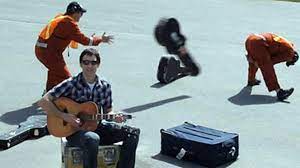The Musician Whose Big Break Was a Broken Instrument

The music industry, like most others, is dominated by a handful of big names. Despite the probably millions of people who have gotten behind a microphone or picked up an instrument, only a lucky few ever end up making a living out of it, and only a subset of those become rich and famous. If you look at the top tracks on the current Apple Music (formerly iTunes) top 100, for example, you’ll likely see a lot of very familiar names (at least if you’re a Gen Z-er) and those same names over and over again. In short, if you want to crack the top 10, you’re going to need a big break. That can come in a lot of ways — a music exec happens to catch your set at a local bar or maybe a radio DJ falls in love with one of your songs and keeps playing it on the air.
Or maybe an airline breaks your guitar.
In 2008, a virtually unknown country musician named Dave Carroll was living in Canada. On March 31st of that year, he and his bandmates, collectively called the Sons of Maxwell, boarded a United Airlines flight at Halifax International Airport en route to Omaha, Nebraska, with a stop-over at Chicago’s O’Hare Airport. Because of the size limitations inherent to carry-on luggage, Carroll and his band checked their instruments with the rest of the luggage, and that proved to be a mistake. When the plane arrived in Chicago, everyone destined for Omaha had to deplane and make a connecting flight; the luggage they had checked was therefore taken off the plane and moved to the Omaha flight as well. But before Caroll and the Sons of Maxwell even got off that first plane, something went wrong. Here’s how he recounts it on his website:
On that first leg of the flight we were seated at the rear of the aircraft and upon landing and waiting to deplane in order to make our connection a woman sitting behind me, not aware that we were musicians cried out: “My god they’re throwing guitars out there.” Our bass player Mike looked out the window in time to see his bass being heaved without regard by the United baggage handlers.
They didn’t see Carroll’s guitar actually being thrown, but it, too, had been tossed aside like someone’s sack of laundry. And unfortunately, Carroll’s guitar — a 710 Taylor which retailed for about $3,500 at the time — didn’t survive the incident. The base of the guitar had been smashed, rendering it unplayable.
For the next few months, Carroll tried to get United to compensate him for his loss; from his perspective, the airline did the damage and should pay to fix it. Unfortunately, he got nowhere. The plane he boarded in Halifax was actually operated by Air Canada, despite being branded “United,” and United told Carroll he had to get compensation from them. Air Canada, though, said that United was responsible for breaking the guitar — it was United employees, not Air Canada ones, who unloaded the plane in Chicago. After nine months of back and forth, United finally made him an offer: $1,200 in flight vouchers.
Carroll gave up arguing — he wasn’t showing any talent for it. His true talent was singing and writing songs. So instead of fighting with the airlines, he decided to sing a song about it. On July 9, 2009, he released the following music video on YouTube.
It’s a catchy tune — fair warning, if you watch it more than once, it may get stuck in your head for the rest of the day. The 4-minute, 36-second retells the story of the broken guitar, Carroll’s failed efforts to get compensation, and “how he should have flown with someone else or gone by car” because, as the song title and refrain drive home, “United breaks guitars.”
Carroll’s goal here was to needle United a bit — he had hoped that the song would reach a million views on YouTube. The ploy worked. Within a day, the music video racked up 150,000 views, and United took notice, reaching out to Carroll on July 10th. But by then, the video had already taken on a life of its own. Within three days, the video had half-a-million views, and within a month, it reached five million, crushing Carroll’s goal. And that was just the tip of the iceberg. Carroll released the song as a 99-cent digital download and, as the Toronto Star reported, “the song became the number one download on iTunes the week after it went viral.” He also released two follow-up songs which did reasonably well, just not as good as the original.
All-in-all, Carroll came out ahead in the end. Taylor Guitars decided to replace Carroll’s instrument for free, he easily made back enough to pay for a new guitar (and produce the music video), wrote a book about the power of the consumer’s voice in a world of social media, and now makes a living as a speaker on the importance of customer service. Nevertheless, United decided to offer him $3,000 — half in cash, half in flight vouchers — to make up for the damage anyway. He turned them down, instead asking them to donate the money to a music education charity, which they did.
Bonus fact: Carroll’s ordeal probably won’t happen again, at least not in the United States. In 2012, Congress passed the FAA Modernization and Reform Act, which in part (and with some limitations), requires airlines to “permit a passenger to carry a violin, guitar, or other musical instrument in the aircraft cabin, without charging the passenger a fee in addition to any standard fee.”
From the Archives: How to Fly with a Cello: A side-effect of the United Breaks Guitar song law.
